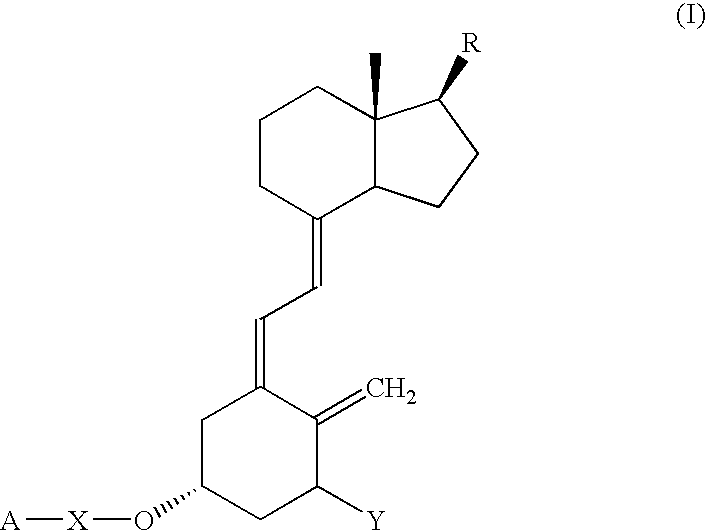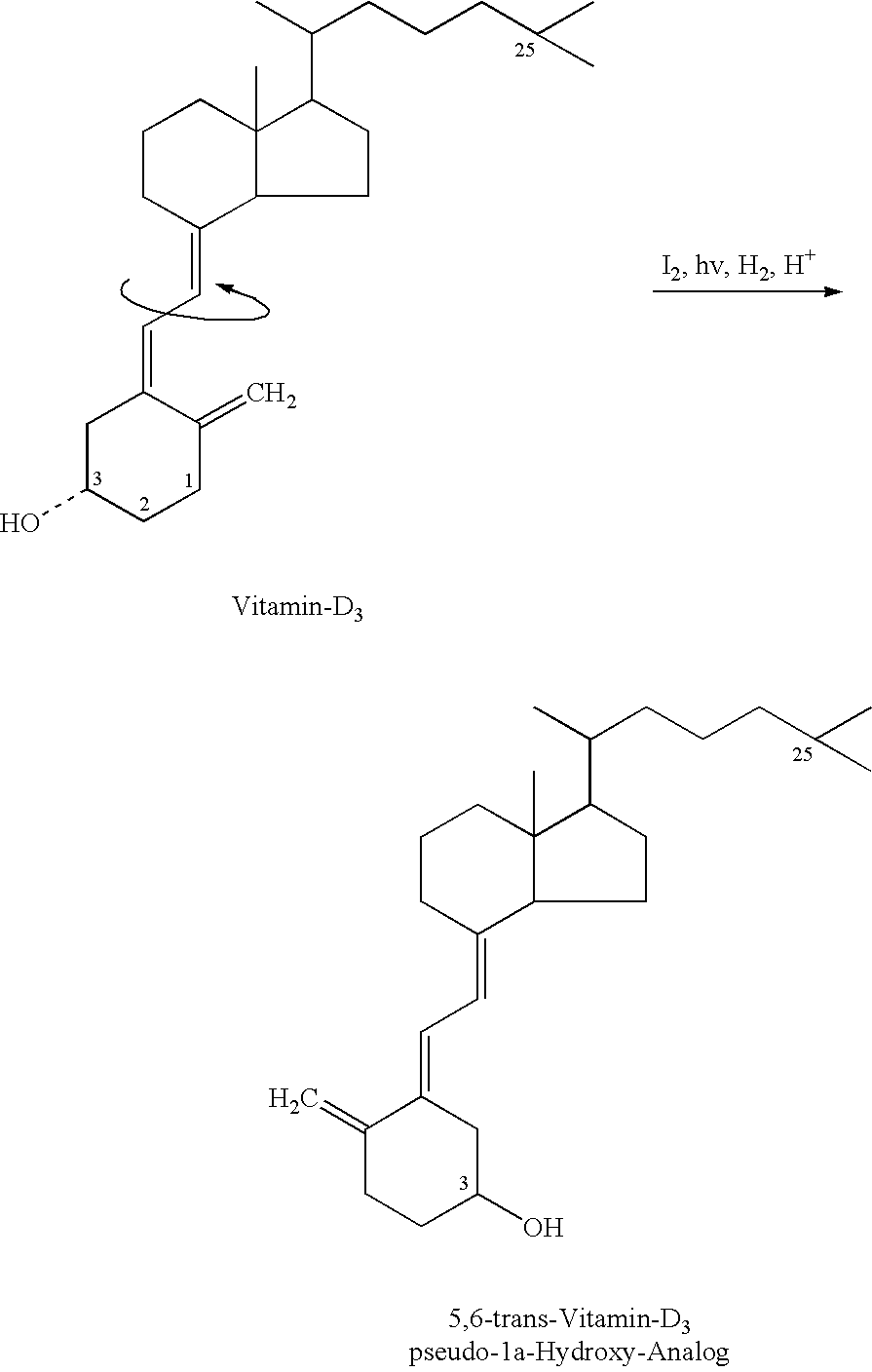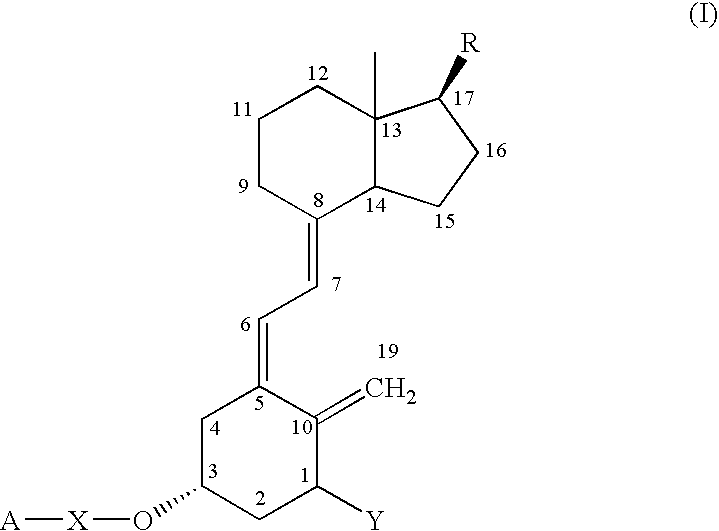Functional vitamin D derivatives and a method for determining 25-hydroxy-vitamin D and 1alpha, dihydroxy-vitamin D
a technology of vitamin d derivatives and functional vitamins, applied in the direction of material analysis, material testing goods, instruments, etc., can solve the problems of inability to meet the requirements of use,
- Summary
- Abstract
- Description
- Claims
- Application Information
AI Technical Summary
Problems solved by technology
Method used
Image
Examples
example 1
Synthesis of 25-OH-Vit.-D.sub.3 -3.beta.-3'[6-N-(biotinyl)-hexamido]amidopropylether (4)
All reactions were performed in the dark in a dry nitrogen atmosphere. Intermediate products were stored at -20.degree. C. HPLC-pure solvents were employed. The 25-OH-vitamin D.sub.3 was obtained from BIOMOL Feinchemikalien GmbH, Hamburg, the LC-BHNS (Long-Chain-Biotinyl-N-.epsilon.-amino caproyl-hydroxy-succinimide ester) from Sigma Chemie, and all further chemicals from Fluka, Darmstadt. The mass spectroscopy (FAB) was carried out with a Finigan-MAT-90, the NMR-measurements with a Bruker-ARX-400 (400 MHz) or a Bruker-ARC-250F (250 MHz).
(i) 25-OH-Vitamin D.sub.3 -3.beta.-cyanoethylether (2)
5 mg 25-OH-vitamin D.sub.3 (12.5 .mu.Mol), dissolved in methylene chloride (CH.sub.2 C.sub.2), was transferred into a vial filled with nitrogen and the solvent was distilled off. The solid remainder was dissolved in 1 ml acetonitrile and mixed with 10 drops of a mixture of tertiary butanol and acetonitrile (9:...
example 2
Stability of 25-OH-Vit.-D.sub.3 -3.beta.-3'[6-N-(biotinyl)-hexamido]amidopropylether
In each case 20 mg purified 25-OH-D.sub.3 -biotin compound (25-OH-vitamin D.sub.3 -3.beta.-3'[6-N-(biotinyl)-hexamido]amidopropyl-ether) from Example 1 was placed in an NMR test tube to which 1 ml solvent was added. The solvent was a mixture of deuterium chloroform:deuterium acetonitrile: D.sub.2 O in the ratio 3:2:1 with a pH-value between 4 and 5. The samples were stored for 200 days under the conditions set out below and the NMR spectra were investigated at regular intervals.
Sample 1: light excluded at -20.degree. C.;
Sample 2 light excluded at +4-6.degree. C.;
Sample 3: light excluded at room temperature;
Sample 4: subject to strong light (on a window ledge) at room temperature.
Samples 1 and 2 showed no substantial alteration in NMR-spectrum over the entire time. An HPLC analysis confirmed that samples 1 and 2 were intact even after 200 days in protonic solvent. Sample 3 showed a minimal alteration ...
example 3
25-Hydroxy Vitamin D-ELISA with 25-Hydroxy Vitamin D.sub.3 -3.beta.-3'[6-N-(biotinyl)-hexamido]amidopropylether
The detection was effected in accordance with the principle illustrated in FIG. 2. For this purpose, 25-OH-vitamin D-3.beta.-3'[6-N-(biotinyl)hexamidol]amidopropylether had to be bound to a solid phase via streptavidin.
(i) Coating a Microtitration Plate with Streptavidin
Into each of the wells of a microtitration plate there was placed 100 ng streptavidin, dissolved in 200 .mu.l 60 nM NaHCO.sub.3, pH 9.6, and the plate incubated overnight at 4.degree. C. The streptavidin solution in the well was removed and each well washed five times with 200 .mu.l washing buffer (PBS, pH 7.4 with 0.05% Tween-20). Then, 250 .mu.l assay buffer was placed in each well. For the assay buffer, 5 g casein was dissolved in 100 ml 0.1 N NaOH and topped up with PBS, pH 7.4 to 1 L volume. The solution was boiled for one hour, the volume supplemented to 1 liter with distilled water, the pH value set t...
PUM
 Login to View More
Login to View More Abstract
Description
Claims
Application Information
 Login to View More
Login to View More - R&D
- Intellectual Property
- Life Sciences
- Materials
- Tech Scout
- Unparalleled Data Quality
- Higher Quality Content
- 60% Fewer Hallucinations
Browse by: Latest US Patents, China's latest patents, Technical Efficacy Thesaurus, Application Domain, Technology Topic, Popular Technical Reports.
© 2025 PatSnap. All rights reserved.Legal|Privacy policy|Modern Slavery Act Transparency Statement|Sitemap|About US| Contact US: help@patsnap.com



